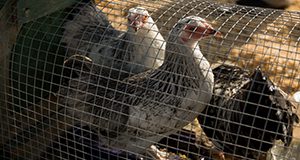Raising backyard chickens is an increasingly popular way to explore self-sufficiency, connect with how our food is produced, and gain experience for future dabbling in food production. This 13-page publication is designed primarily for those considering raising backyard chickens for eggs for personal consumption. Written by Mary E. Henry, Jessica M. Ryals, Alicia Halbritter, and Derek L. Barber, and published by the UF/IFAS Department of Animal Sciences, revised November 2019.
http://edis.ifas.ufl.edu/an239
Tag: Eggs
Protecting Perishable Foods During Transport by Truck and Rail
The importance of protecting perishable foods from loss of quality during transport has long been recognized. Increased recognition of the importance of the transport link in the food distribution cold chain in securing the safety of perishable foods has more recently become as well recognized.
This updated edition reflects the dynamic changes and innovations in the handling and transportation of perishable foods. Some of these include improved insulation and air movement, microprocessors for more efficient refrigeration, expert systems to control the transport environment and conserve fuel energy, and the use of telematics to monitor and control the performance of refrigerated vehicles during transit. This edition includes descriptions and recommendations for food transported over the road and by rail in marine containers, as well as in railcars. This 214-page revision was written by J. K. Brecht, Steven A. Sargent, Patrick E. Brecht, Jorge Saenz, and Leonard Rodowick and published by the UF/IFAS Horticultural Sciences Department in cooperation with the USDA AMS Transportation Services Division.
http://edis.ifas.ufl.edu/hs1328
A Consumer's Guide to Eggs
 People have been eating eggs for centuries. Records as far back as 1400 BC show that the Chinese and Egyptians raised birds for their eggs. The first domesticated birds to reach the Americas arrived in 1493 on Christopher Columbus' second voyage to the New World. Most food stores in the United States offer many varieties of chicken eggs to choose from — white, brown, organic, cage free, vegetarian, omega-3 fatty acid enriched, and more. The bottom line is that buying eggs is not as simple as it used to be because more choices exist today. This 4-page fact sheet will help you understand the choices you have as a consumer, so you can determine which variety of egg suits you and your family best. Written by Jeanine Beatty, Karla Shelnutt, and Gail Kauwell, and published by the UF Department of Family Youth and Community Sciences, April 2013.
People have been eating eggs for centuries. Records as far back as 1400 BC show that the Chinese and Egyptians raised birds for their eggs. The first domesticated birds to reach the Americas arrived in 1493 on Christopher Columbus' second voyage to the New World. Most food stores in the United States offer many varieties of chicken eggs to choose from — white, brown, organic, cage free, vegetarian, omega-3 fatty acid enriched, and more. The bottom line is that buying eggs is not as simple as it used to be because more choices exist today. This 4-page fact sheet will help you understand the choices you have as a consumer, so you can determine which variety of egg suits you and your family best. Written by Jeanine Beatty, Karla Shelnutt, and Gail Kauwell, and published by the UF Department of Family Youth and Community Sciences, April 2013.
http://edis.ifas.ufl.edu/fy1357

